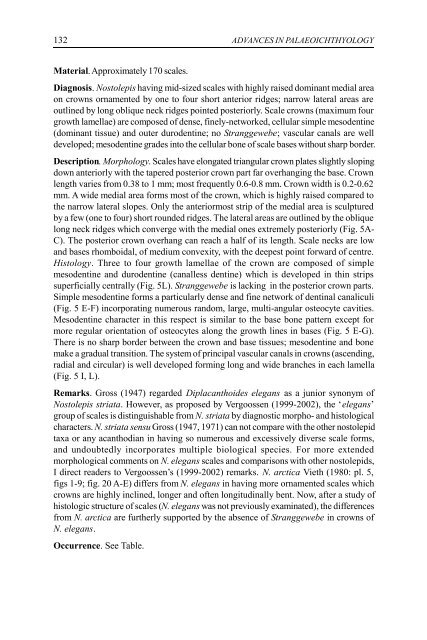Zemes un vides zinātnes Earth and Environment Sciences - Latvijas ...
Zemes un vides zinātnes Earth and Environment Sciences - Latvijas ...
Zemes un vides zinātnes Earth and Environment Sciences - Latvijas ...
Create successful ePaper yourself
Turn your PDF publications into a flip-book with our unique Google optimized e-Paper software.
132<br />
ADVANCES IN PALAEOICHTHYOLOGY<br />
Material. Approximately 170 scales.<br />
Diagnosis. Nostolepis having mid-sized scales with highly raised dominant medial area<br />
on crowns ornamented by one to four short anterior ridges; narrow lateral areas are<br />
outlined by long oblique neck ridges pointed posteriorly. Scale crowns (maximum four<br />
growth lamellae) are composed of dense, finely-networked, cellular simple mesodentine<br />
(dominant tissue) <strong>and</strong> outer durodentine; no Stranggewebe; vascular canals are well<br />
developed; mesodentine grades into the cellular bone of scale bases without sharp border.<br />
Description. Morphology. Scales have elongated triangular crown plates slightly sloping<br />
down anteriorly with the tapered posterior crown part far overhanging the base. Crown<br />
length varies from 0.38 to 1 mm; most frequently 0.6-0.8 mm. Crown width is 0.2-0.62<br />
mm. A wide medial area forms most of the crown, which is highly raised compared to<br />
the narrow lateral slopes. Only the anteriormost strip of the medial area is sculptured<br />
by a few (one to four) short ro<strong>un</strong>ded ridges. The lateral areas are outlined by the oblique<br />
long neck ridges which converge with the medial ones extremely posteriorly (Fig. 5A-<br />
C). The posterior crown overhang can reach a half of its length. Scale necks are low<br />
<strong>and</strong> bases rhomboidal, of medium convexity, with the deepest point forward of centre.<br />
Histology. Three to four growth lamellae of the crown are composed of simple<br />
mesodentine <strong>and</strong> durodentine (canalless dentine) which is developed in thin strips<br />
superficially centrally (Fig. 5L). Stranggewebe is lacking in the posterior crown parts.<br />
Simple mesodentine forms a particularly dense <strong>and</strong> fine network of dentinal canaliculi<br />
(Fig. 5 E-F) incorporating numerous r<strong>and</strong>om, large, multi-angular osteocyte cavities.<br />
Mesodentine character in this respect is similar to the base bone pattern except for<br />
more regular orientation of osteocytes along the growth lines in bases (Fig. 5 E-G).<br />
There is no sharp border between the crown <strong>and</strong> base tissues; mesodentine <strong>and</strong> bone<br />
make a gradual transition. The system of principal vascular canals in crowns (ascending,<br />
radial <strong>and</strong> circular) is well developed forming long <strong>and</strong> wide branches in each lamella<br />
(Fig. 5 I, L).<br />
Remarks. Gross (1947) regarded Diplacanthoides elegans as a j<strong>un</strong>ior synonym of<br />
Nostolepis striata. However, as proposed by Vergoossen (1999-2002), the ‘elegans’<br />
group of scales is distinguishable from N. striata by diagnostic morpho- <strong>and</strong> histological<br />
characters. N. striata sensu Gross (1947, 1971) can not compare with the other nostolepid<br />
taxa or any acanthodian in having so numerous <strong>and</strong> excessively diverse scale forms,<br />
<strong>and</strong> <strong>un</strong>doubtedly incorporates multiple biological species. For more extended<br />
morphological comments on N. elegans scales <strong>and</strong> comparisons with other nostolepids,<br />
I direct readers to Vergoossen’s (1999-2002) remarks. N. arctica Vieth (1980: pl. 5,<br />
figs 1-9; fig. 20 A-E) differs from N. elegans in having more ornamented scales which<br />
crowns are highly inclined, longer <strong>and</strong> often longitudinally bent. Now, after a study of<br />
histologic structure of scales (N. elegans was not previously examinated), the differences<br />
from N. arctica are furtherly supported by the absence of Stranggewebe in crowns of<br />
N. elegans.<br />
Occurrence. See Table.
















